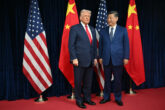March 28, 2023
Agile Ukraine, Lumbering Russia: The Promise and Limits of Military Adaptation
During more than 13 months of war against one of the world’s largest armies, Ukraine’s military has continually stood out for one quality in particular: its ability to adapt. Over and over, Ukraine has nimbly responded to changing battlefield dynamics and exploited emerging technologies to capitalize on Russia’s mistakes. Despite their limited experience with advanced weapons technology, Ukrainian soldiers quickly graduated from point-and-shoot Javelin and Stinger missile systems to the more sophisticated High Mobility Artillery Rocket System (HIMARS), which they have used to pummel Russian command centers, logistical assets, and ammunition depots. They have deployed military and commercial drones in increasingly creative ways. And although this is not the first war to play out on social media, the Ukrainians have been giving the world a master class in effective information operations in the digital age. Such is their record of technical and tactical versatility that Ukrainian forces continue to enjoy a sense of momentum, despite the fact that the frontlines have been largely frozen for months.
Unlike its enemy, Ukraine has been able to learn from and respond to unexpected and shifting battlefield conditions.
By contrast, Russian forces have shown limited openness to new tactics or new technologies. Hobbled by bad leadership and terrible morale, the Russian military was slow to recover from its disastrous attempt to seize Kyiv in February 2022 and has struggled to adjust its strategy or learn from its mistakes. This is despite having demonstrated considerable dexterity in its deployments in eastern Ukraine in 2014 and in Syria starting in 2015. In the current war, although Russian military leaders have made some adjustments to alleviate logistical problems and improve coordination on the ground, the Kremlin’s core strategy continues to rely largely on throwing more manpower and firepower at the enemy—a lumbering, high-cost approach that has hardly inspired confidence. Observing this performance, some Western experts have raised the possibility of exceedingly dire scenarios, including a doomed Russian spring offensive, a large-scale mutiny of troops, or even the collapse of Russian President Vladimir Putin’s regime.
Read the full article from Foreign Affairs.
More from CNAS
-
Indo-Pacific Security / Technology & National Security
CNAS Insights | The Cost of Silence on China’s Cyber AggressionJust weeks before the much anticipated meeting between President Donald Trump and General Secretary Xi Jinping, the United States discovered yet another major China-backed cyb...
By Morgan Peirce
-
Defense / Technology & National Security
What to Expect from Military AI in 2030As the US military races to harness artificial intelligence, experts say the biggest AI breakthroughs may not come from “killer robots” or autonomous war machines, but from al...
By Josh Wallin
-
Defense / Indo-Pacific Security / Technology & National Security
To Compete with China on Military AI, U.S. Should Set the StandardsThe United States has an opportunity to lead in global norms and standards for military AI at a critical moment, when the foundations laid today could shape how militaries use...
By Jacob Stokes, Paul Scharre & Josh Wallin
-
Defense / Energy, Economics & Security / Technology & National Security
The Outlook CEO Perspectives on Risk, Resilience and ReturnsJoin David Schwimmer and Richard Fontaine, CEO of the Center for New American Security, as they explore the current national security landscape and its impacts on global econo...
By Richard Fontaine




